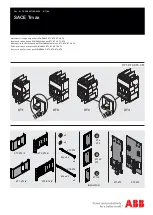
38
Function Description
EPSITRON®
787-1668 Electronic Circuit Breaker
Manual
Version 1.1.0
6.6.2
Specific Activation and De-activation of Non-Tripped
Output Channels
A coded pulse pattern must be present to activate and de-activate specific output
channels. The encoded pulse pattern can consist of
•
17 bits or
•
89 bits (with Firmware 2.0 and higher),
which must be transmitted as "Manchester code" (based on IEEE 802.3). Here, a
falling clock pulse denotes a logical zero ("0"), and a rising clock pulse a logical
one ("1").
The first bit to be transmitted has the value "0" and serves as the start bit, after
which either 16-bit or 88-bit user data is transmitted.
No separate pulse signal is applied; the electronic circuit breaker obtains the pulse
signal from the pulse pattern that is received. The circuit breaker is then
synchronized automatically and transmits the current status back via signal output
S2.
The table below provides an overview of the functions for the individual data bits:
Table 20: Bit Allocation for Control Input S1
Bit
Output
channel
Byte
Function
1
START bit, value = "0"
2
Channel 8
Byte 1
Required switching statuses of output channels
"1" = The corresponding output channel is
activated.
"0" = The corresponding output channel is
deactivated.
3
Channel 7
4
Channel 6
5
Channel 5
6
Channel 4
7
Channel 3
8
Channel 2
9
Channel 1
10
Command
bit
"switching
status"
Byte 2
"1" = The required switching statuses of the
output channels (Byte 1) are accepted.
"0" = The required switching statuses of the
output channels (Byte 1) are ignored.
11
Command
bit
"protocol
length"
"1" = The extended 89-bit protocol is being
used; the circuit breaker is transferring
additional user data.*
"0" = The short 17-bit protocol is being used.



































